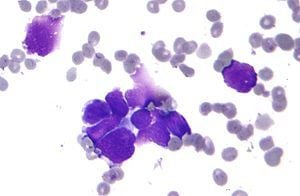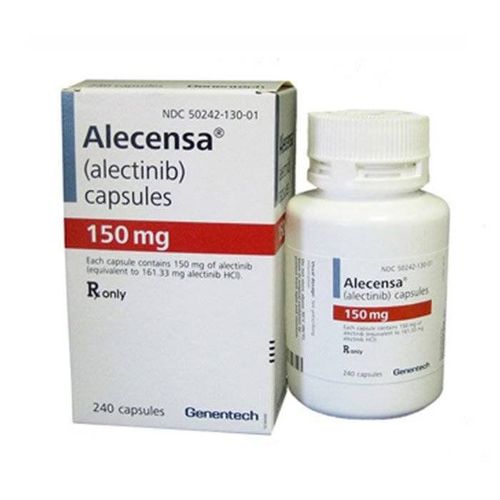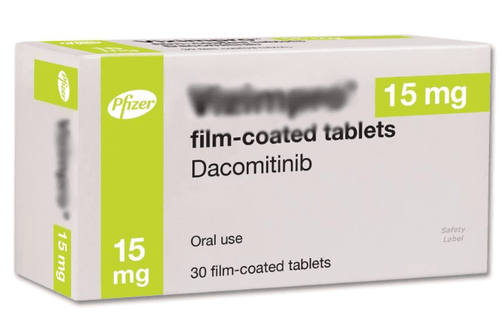This is an automatically translated article.
Post by Master, Doctor Ha Thi Thu Hien - Pathologist - Laboratory Department - Vinmec Times City International Hospital
Lung cancer is the second most common cancer and the leading cause of cancer death in both men and women, accounting for nearly 25% of all cancer deaths. However, the number of new lung cancer cases is also continuing to decline, in part because of people giving up smoking and advances in early detection and treatment.
1. What is lung cancer?
Lungs are 2 sponge-like organs in the ribcage. The right lung has 3 parts or lobes. The left lung has 2 lobes and is smaller because the heart occupies part of the area.
When inhaled, air enters the mouth or nose and enters the lungs through the trachea. The trachea divides into tubes called bronchi, which enter the lungs and divide into smaller bronchi. At the end of the bronchi form smaller branches called bronchioles.
Lung cancer usually starts in the cells that line the bronchi and parts of the lungs such as the bronchioles or alveoli.
There are 2 main types of lung cancer:
Non-small cell lung cancer (NSCLC) About 80% to 85% of lung cancers are NSCLC. adenocarcinoma, squamous cell carcinoma, and large cell carcinoma.Under this subtype, the different lung cell types are grouped together as NSCLC because of the treatment and prognosis of the disease. they are often similar
adenocarcinoma starts in cells that normally secrete substances such as mucus This type of lung cancer is more common in women than in men and more likely to occur in people younger than other types of lung cancer
Squamous cell carcinoma begins in squamous cells, which are flat cells that line the inside of the airways in the lungs. people with a history of smoking
Large cell carcinoma can appear in any part of the lung It tends to grow and invade quickly, can be more difficult to treat. A type of large cell carcinoma, called large cellneuroendocrine carcinoma, grows rapidly and resembles small cell lung cancer.
Some other subtypes of NSCLC, such as adenosquamous carcinoma and sarcomatoid carcinoma, are less common.
Small cell lung cancer About 10-15% of all lung cancers are small cell lung cancer and it is sometimes called oat cell cancer.
This type of lung cancer tends to grow and spread faster than small cell lung cancer. About 70% of people with small cell lung cancer have had spread by the time they are diagnosed. Because this cancer grows quickly, it tends to respond well to chemotherapy and radiation. Unfortunately, for most people, cancer will come back at some point.

Along with the common main types of lung cancer, other tumors can appear in the lungs such as:
Lung carcinoid tumors Other lung tumors such as follicular carcinoma, lymphoma and sarcoma, c tumors Benign lung tumors are rare. Cancer that has spread to the lungs, such as the breast, pancreas, kidneys, or skin. For example, cancer that starts in the breast and metastasizes to the lungs is still breast cancer, not lung cancer. Treatment for metastatic lung cancer is based on where it started (where the cancer started).
2. How common is lung cancer?
Lung cancer (both small and non-small cell) is the second most common cancer in both men and women. In men, prostate cancer is the most common, while in women it is breast cancer.
American Cancer Society estimates for lung cancer in the United States for 2021 are:
Approximately 235,760 new cases of lung cancer (119,100 in men and 116,660 in women) Approximately 131,880 lung cancer deaths (69,410) in men and 62,470 in women) Lung cancer mainly occurs in older people. Most people diagnosed with lung cancer are 65 or older; a very small number of people diagnosed are under 45 years of age. The average age of people at diagnosis is around 70.
Currently, lung cancer is the leading cause of cancer death in both men and women, accounting for almost 25% of all cancer deaths. . Each year, more people die from lung cancer than from colon, breast, and prostate cancers.
On the plus side, the number of new lung cancer cases continues to decline, in part because people quit smoking and advances in early detection and treatment.
3. A person's lifetime chance of getting lung cancer
Overall, the chance that a man will develop lung cancer in his lifetime is about 1 in 15, for women it is about 1 in 17. These numbers include both smokers and non-smokers.
For smokers the risk is much higher, while for non-smokers the risk is lower.
Black men have about 15% higher risk of lung cancer than white men. Black women are about 14% lower than white women.
Black and white women have lower cancer rates than men, but the gap is closing. Cancer rates have fallen in men over the past few decades, but in women only in the last decade.
Although their overall risk of lung cancer is higher, black men are less likely to develop small cell lung cancer (SCLC) than white men.
Survival statistics after diagnosis in people with lung cancer vary depending on the stage of the cancer at the time of diagnosis.
Although lung cancer has a poor prognosis, some people with early stage lung cancer are still cured.

4. Diagnosis of lung cancer
Fluorescence bronchoscopy Also known as automated fluoroscopy bronchoscopy, this technique can help doctors detect some lung cancers earlier, more easily. For this test, the doctor inserts an endoscope through the mouth or nose into the lungs. The endoscope has a special fluorescent light attached to it, instead of the normal light (white light).
Electromagnetic navigation bronchoscopy Proximal lung tumors can be biopsied during bronchoscopy, but the bronchoscope has difficulty in reaching the peripheral tumors microscopic lung, so tumors in these areas are usually biopsied by inserting a needle through the skin.
5. Lung cancer treatment
Surgery Doctors now use video-assisted thoracic surgery (VATS) to treat some small lung tumors. This method allows doctors to remove a lung tumor through a smaller incision, shortening the hospital stay and causing less pain to the patient. The method is also being studied to see if it can be used for larger lung tumors.
A newer approach to this type of surgery is that the surgeon uses a control panel inside the operating room to maneuver long surgical instruments using a robotic arm. This method, called robotic-assisted surgery, is now being used in some larger cancer centers. It is currently unclear whether this surgical approach is better than traditional surgery.
Real images of tumors Researchers are finding ways to use new imaging techniques, such as 4D computed tomography, to help improve treatment. In this technique, the CT scans the chest continuously for about 30 seconds. It shows where the tumor is in relation to other structures when a person breathes, as opposed to just giving a 'snapshot' of a moment, like a standard CT would.
Targeted drugs Researchers are learning more about how lung cancer cells work to control their growth and spread. This work has led to the development of targeted drugs, many of which have been used to treat NSCLC. Targeted drugs approved for use in other cancers currently being studied in NSCLC have an alteration in the RET gene. These drugs include Sunitinib, Sorafenib, Vandetanib, and Cabozantinib.
Whole brain radiation therapy for brain metastases Brain metastases are common in people with lung cancer and often lead to worse outcomes. Radiation therapy for brain metastases is the usual treatment and may have some long-term side effects. For patients with lung cancer with limited brain metastasis, newer radiotherapy techniques, such as SRS, only target the tumor and not the rest of the brain. This method has few side effects and is still effective in treating cancer.

Maintenance Treatment For people with end-stage lung cancer receiving chemotherapy, a combination of both chemotherapy drugs (sometimes along with a targeted drug) is usually given for about 4 to 6 cycles. Some studies have found that for NSCLC cancers that do not get worse with treatment, continued treatment with a single chemotherapy drug such as pemetrexed or with a target drug after 4 to 6 cycles may be possible. help some people live longer.
This is known as maintenance therapy. One possible downside to this treatment is the side effects of the medication. Maintenance treatment is suggested more often, but it is not an option for some people with uncontrolled cancer or those in poor health.
Immunotherapy Researchers are developing immunotherapy drugs that can help a person's immune system fight cancer.
Immune checkpoint inhibitors Cancer cells can sometimes avoid being attacked by the body's immune system by using certain "checkpoints" that normally keep the system in check immunity. For example, cancer cells often have a lot of a protein called PD-L1 on their surface that helps them evade the immune system. The new drug blocks the PD-L1 protein or PD-1 protein, respectively, on immune cells called T cells, which can help the immune system recognize cancer cells and attack them.
One of the drugs currently approved for use in advanced NSCLC. Current studies are looking at whether using immunotherapy drugs along with radiation therapy, which is available to people who cannot have surgery, can make tumors shrink, helping people live longer.
6. Prevention of lung cancer
Prevention offers the greatest chance to fight lung cancer. Decades have passed because the link between smoking and lung cancer has become clear, so research is continuing:
Finding ways to help people quit smoking and passive smoking through through counseling, nicotine replacement and other drugs Persuading young people to never smoke Genetic differences in genes may make some people more likely to develop lung cancer if they smoke or exposure to the smoke of others (passive smoking). The researchers also continued to look at a number of other causes of lung cancer, such as radon exposure and diesel emissions. Finding new ways to limit this exposure can reduce your risk of getting sick.
Use vitamins or drugs to prevent lung cancer in high-risk groups, but so far no method has been shown to reduce the risk unequivocally. Some studies have suggested that a diet rich in fruits and vegetables may protect against cancer, but more research is needed to confirm this. While any protective effect of fruits and vegetables on lung cancer risk is likely to be much smaller than the risk from smoking, the American Cancer Society's dietary recommendations (such as keeping a healthy weight and eating a diet rich in fruits, vegetables, and whole grains) can still help.
Screening with helical CT scans of people at high risk for lung cancer (due to a history of smoking) reduces the risk of dying from lung cancer, when compared with chest X-rays.
In particular, lung cancer screening is the most effective measure for you to detect and promptly treat lung cancer, protect your health and life. Currently, Vinmec International General Hospital has a Lung Cancer Screening Package with many outstanding advantages such as:
A team of highly qualified and experienced doctors. Comprehensive professional cooperation with domestic and international hospitals: Singapore, Japan, USA, .. Comprehensive treatment and care, multi-specialty coordination towards individualizing each patient. Having a full range of specialized facilities to diagnose the disease and stage it before treatment: Endoscopy, CT scan, PET-CT scan, MRI, histopathological diagnosis, gene-cell testing, .. Full range of main cancer treatment methods: surgery, radiation therapy, chemotherapy, stem cell transplant... When registering for the Lung Cancer Screening Package at Vinmec, customers will receive:
Examination respiratory specialist Low-dose computed tomography lung tumor screening.
Please dial HOTLINE for more information or register for an appointment HERE. Download MyVinmec app to make appointments faster and to manage your bookings easily.














